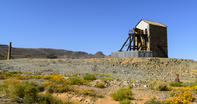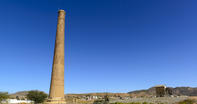The Big One at Okiep
The biggest copper mine in Namaqualand was O’okiep. It began life in 1856 with one small shaft and by 1860 it was the most important mine in the region. Ten years later, it was described as the richest copper mine in the world.

Accordingly, it was a large settlement with stores, stables, workshops, machinery, steam engine, school, store, infirmary, residences and cottages. By 1870, the mine was 75- 90 metres deep with a population that was approaching 1500. A few years later, the mine was nearly 150 metres deep and it took 20 minutes to climb up the ladders from the lowest levels to the surface.
Labour at O’okiep was divided into ‘tut-work’ (sinking shafts) and ‘tribute work’ (getting ore to surface). Most of this was done by black labourers under the supervision of white miners. Salaries were relatively high, with qualified miners from Britain earning between £8-£12 pounds per month.
In stark contrast, the black workers were paid 1s 6d per day. Women and children, who were employed to sort the ore by hand and do other ‘menial’ jobs were paid 4 pennies a day. At the time, this wage gap was considered to entirely appropriate given the difference between the mine owners and workers.
The Mine Continued to Grow

Despite the professed generosity of the company, O’okiep (and the other mines in the area) often experienced a shortage of labourers, especially when the rains were good and locals returned to their farms. As a result, workers were brought in from all over the world. By 1875 the population totalled 1752 people, living in 73 houses and 367 huts and tents.
A contemporary traveller described the ‘copper wonder’ as follows: "there is a perpetual clatter which, to a stranger, is very disturbing, but which is not noticed by those resident, unless there is a stoppage, when everyone looks up to see what is the matter.
The people are called to work by a huge steam whistle, which can be heard for many a mile. Almost every nation finds its representatives there - English, French, German, Italian, Portuguese, the colonial Dutch and ‘Afrikaners’, and as for the numerous native races, I would scarcely like to say which African race is not there. Here you see men from the far interior, West and East Coast of Africa, Lascars, Indians, Fingoes, Hottentots, Bushmen and the various Damara nations, and all the wonderful crosses produced by marriage amongst such a mixed population."
And still the mine continued to grow. In 1882, it had a population of around 2000, eight stores, two churches, two schools, a hospital, a post office, a telephone service and a telegraph line. By this time, the mine was so successful it had started to pollute the environment and many people died from the bad air and contaminated water.
A Sure Sign of Prosperity
But the mine was too good a proposition to slow down. In 1884 production was reported at 15 000 tons of 30% copper ore, the mine had over 900 employees and the resident magistrate said that ‘I have never been in touch with a community where there is such a constant undercurrent of scandalous innuendo as there was at O’okiep’.
Apparently, moral decline is a sure sign of prosperity. Four years later, the mine had 2000 employees, with huts of the Damara labourers (from Namibia) on one side of the valley and Khoikhoi huts on the other. Popular prejudice against the Khoikhoi had not diminished over the years and it was declared that "The Damara is a steady, hardworking, reticent, thrifty native.
The Hottentot on the other hand is thriftless, careless and happy-go-lucky." Despite these misgivings, O’okiep continued to produce ore through most of the twentieth century before it was closed for good. Today, Okiep (as it is now spelled) is a quaint place. The smokestack of the old reduction works is still standing, as is the steam-driven Cornish Pump – the only complete example of its kind in South Africa.
The massive mine dumps are also visible on the edge of town, with their dark green ore glistening in the hot sun. The town currently contains about 7500 inhabitants, and the unemployment rate is sitting at 75%.
By David Fleminger